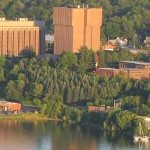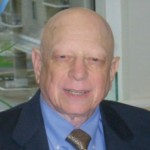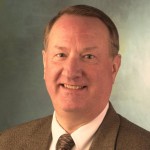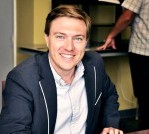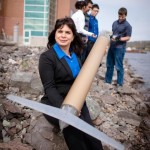Research Professor John Johnson (ME-EM) chaired a National Academy of Engineering (NAE) committee that has published the NAE Review of the 21st Century Truck Partnership, Third Report. Former Michigan Tech President Dale Stein also served on the committee. Johnson has chaired committees that produced several other NAE reports. He also serves on the CAFE (Corporate Average Fuel Economy) standards committee.
Michigan Tech Mobile Lab Helps Engineers Design for Human Comfort: Michigan Tech’s mobile lab will travel to Novi, Mich., on Oct. 28 to serve as the site for a one-day workshop on the use of specially designed human manikins and software to measure air velocity, temperature, radiant heat flux and relative humidity in vehicles. Engineers have been invited to participate in the “Manikinalysis” workshop hosted by Michigan Tech, Thermetrics and ThermoAnalytics. Thermetrics makes the HVAC Manikin and ThermoAnalytics produces the human thermal software.
Michigan Tech alumnus Gregory Hardy has received the Steve Thorne Leadership Award, funded by the GE African American Forum. The award recognizes outstanding leadership in the National Society of Black Engineers.
Hardy graduated with a BS in mechanical engineering from Michigan Tech and is currently a mechanical science and engineering graduate student at the University of Illinois at Urbana-Champaign. Regarding the award, Hardy told the NSBE, “This fuels my fire to do more and inspire others to do the same.”
“Michigan Technological Engineering is known for its space related research and education – aerospace and mechanical engineering” – featured in USA Today special edition “NASA – Beyond Earth” on page 25
Nina Mahmoudian (MEEM) has received a $57,708 grant from the Office of Naval Research for her research project titled, “Toward Undersea Persistence.”
Channel 2, KTVN in Reno, Nevada reported on SAE International’s expansion of its SAE John Johnson Award for Outstanding Research in Diesel Engines to honor individual leaders in the field. Established in 2008, the award traditionally recognized authors of an SAE International outstanding technical paper that addresses research advancements in diesel engines regarding efficiency and low emissions achieved by innovative experimental and modeling research of the engine, fuel and/or after treatment systems.
This prestigious award honors John H. Johnson, a Presidential Professor with Tech’s Department of Mechanical Engineering Mechanics. Read the story.
Dr. Hussein Zbib received the Voiland College of Engineering and Architecture’s 2015 Anjan Bose Outstanding Researcher Award. Professor Hussein earned his BSME, MSME, and PhD in ME-EM all from MIchigan Tech and is a member of our EAB. He is a professor and former head of the School of Mechanical and Materials Engineering at Washington State University.
Research Professor John Johnson (ME-EM) chaired a National Academy of Engineering (NAE) committee that just published the Review of the 21st Century Truck Partnership Third Report. Former Michigan Tech President Dale Stein also served on the NAE committee.
Diesel Engine Aftertreatment Consortium Partner Meeting: The Department of Mechanical Engineering – Engineering Mechanics will host a Diesel Engine Aftertreatment Consortium Partner meeting September 16 in MEEM 1021. Industrial partner representatives from Cummins, John Deere, Daimler-Detroit, Corning, Johnson Matthey and Tenneco will be on campus all day to review research progress during the second year of three year consortium. The focus of the consortium is on experimental and modeling research of advanced diesel after treatment systems and is a part of the APS Labs. John Johnson, Jeff Naber and Gordon Parker are the faculty associated with the Consortium.
